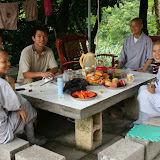 |
| One Heart Children's Home |
I was picked up at the airport on October 1 by Wei Song and he brought me out to visit Venerable Guang Pu, the founder of the Children's Home and Venerable Chuan's teacher. She had just held a Dharma service at Zhunti Temple, presently under construction. The temple, located in the countryside outside of Xiamen, is another of Venerable Guang Pu's projects. The ox-driven carts and bamboo hats (cao mao) that were frequently seen on the trip to the temple were different for me. Also, the mix of locals, Buddhist friends, and venerables at the temple was lively and refreshing. However, from the discussions and activities around the temple it was clear that there were more similarities that differences with Hsi Lai Temple.
I arrived at the Children's Home in Autou and was welcomed by the very compassionate director, Huang Shuangchun. The kids were in the process of planting vegetables in the large vegetable patch in front of the dorm building. It was fun plowing, planting, and watering with the kids under the expert supervision of our Aunty. A batch of volunteers had also arrived that day to help supervise the kids for several days while some of the staff took some time off for the holiday. All the principles to run the Children's Home are from Buddhism, which is very practical, but there is no overt display of Buddhism at the temple, in order to make the Home more acceptable to the community at large, including the volunteers, who may be of any religion or no religion at all. One of the main principles of volunteering at One Heart is to give without expecting in return.
 |
| Xiamen July 4-5, 2009 |
The Children's Home has two locations: Aotuo and Dazhai. To allow the staff at Dazhai to take a break over the holiday and to have one big party for Mid-Autumn Festival all the younger kids from Dazhai came over to stay at Autuo on October 2 making a total of 60 children ranging from 5 years old to 17 years old. The charming kinds were led by their equally charming teacher, Xiao Li. I found out the the younger kids were equally as disciplined and well-behaved as older friends at Autuo. At mealtimes everybody sat silently not touching the food in front of them until the director led them in saying grace, which everyone had memorized and recited in a cute combination of younger and older voices. Grace is some non-demoninational words of thanks composed by Venerable Guang Pu. The kids are very thoughtful and thankful and far ahead of my own son, who needs to be bribed and cajoled into doing any small amount of housework. The director, Huang Shuangchun, is one of the main driving forces behind the positive life at the Children's Home. Her own childhood as an orphan and strong Buddhist faith have a lot to do with that.
That afternoon we went on a trip around the neighborhood to send the traditional moon cakes. Despite the very basic conditions at the Children's home, many of the neighbors lived in much poorer conditions. The neighbors appreciated the moon cakes and seeing the kids. I was surprised at the differences in the customs between the family houses that I was used to in Beijing and those in Xiamen. The entrance to every house had a large shrine where the lounge room should have been for the ancestors of the residents. Additionally, there were statues of Guanyin Bodhisattva or some folk dieties. Also common outside the houses were small local temples devoted to ancestors with similar combinations of Buddhist and folk figures.
October 3 was Mid-Autumn Festival and it takes a special form in Xiamen with the added fun of games of throwing dice where lots of prizes are given away. At this point the 60 kids really made some noise. On October 4 the party had slowed down to the point where we could have some English classes. For the next few days we settled into a pattern of English pronunciation in the morning and English singing in the afternoon. Many of the kids came from Tibet and Sichuan, the later after the 2008 earthquake, and have missed periods of education.
On October 8 the party was over. The younger kids went back to Dazhai and Weisong sent me back to Xiamen airport for my trip back to Beijing.
Alex Amies















